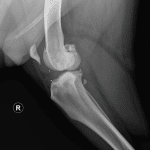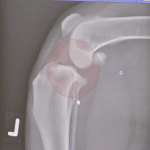Contents
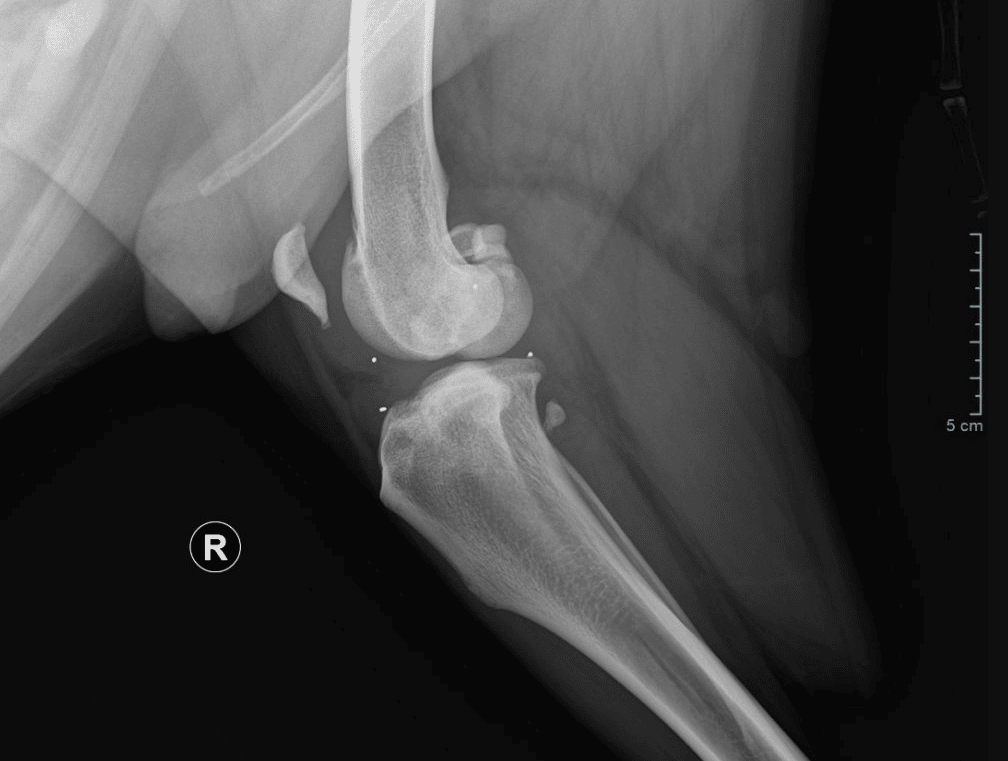
Introduction to cruciate ligament rupture in dogs
The anterior cruciate ligament is particularly important in the knee joint - it enables a hinge movement of the joint and prevents the bony structures from slipping back and forth. Cruciate ligament rupture remains one of the most common orthopedic diseases in dogs.
The diagnosis of cruciate ligament rupture in dogs is a typical sports injury in humans. Things are a little different with our four-legged friends. In addition to the traumatic causes, it is usually a “degenerative process” in dogs, which means that the cruciate ligament shows signs of wear and tear over the years, becomes increasingly thinner and eventually tears. The changes to the ligament structure increase with advanced age and as the dog's body weight increases (poor training status also has negative effects).
The final tear of the cruciate ligament (canine cruciate ligament tear - we have written a separate page on the subject of cats ) usually causes only mild to moderate pain. Although many dogs initially no longer put any weight on the affected leg at all, an apparent improvement occurs within 2 to 3 weeks - the dogs partially put weight on again until suddenly there is another deterioration: this is often the moment when the inner meniscus is massive is damaged (essentially a “shock buffer” between the bony parts of the joint).
The instability of the joint causes enormous problems for the dog; the bones shift against each other with every load - the dog feels insecure. The situation gets worse over time with the first signs of osteoarthritis or a painful joint effusion.
Causes of cruciate ligament rupture in dogs
Some dog breeds are more susceptible to cruciate ligament tears due to their anatomy. They are particularly common in larger dogs such as Rottweilers, Newfoundlands and Staffordshire Terriers. The knee joint biomechanics in dogs differs from that in humans, which is why surgical techniques from human medicine cannot simply be transferred.
Anatomy of the knee joint
The knee joint is a hinge joint with approximately 30° rotation. It consists of the thigh (femur), the shinbone (tibia), the fibula (fibula) and the kneecap (patella). The stability of the joint is ensured by two straight collateral ligaments and the two cruciate ligaments. The cruciate ligaments prevent the knee from twisting significantly and the lower leg from sliding forward. Between the bones lie the menisci, which have shock-absorbing and stabilizing functions.
The cruciate ligament is one of the most important tendons of the knee
Together with the collateral ligaments, the cruciate ligaments stabilize the knee joint. Each knee joint has an external and an internal cruciate ligament, which are actively involved in extending the leg. The cruciate ligament gets its name because the two ligaments cross in the middle of the knee joint. If one of the cruciate ligaments tears, the stability and mobility of the knee is severely limited.
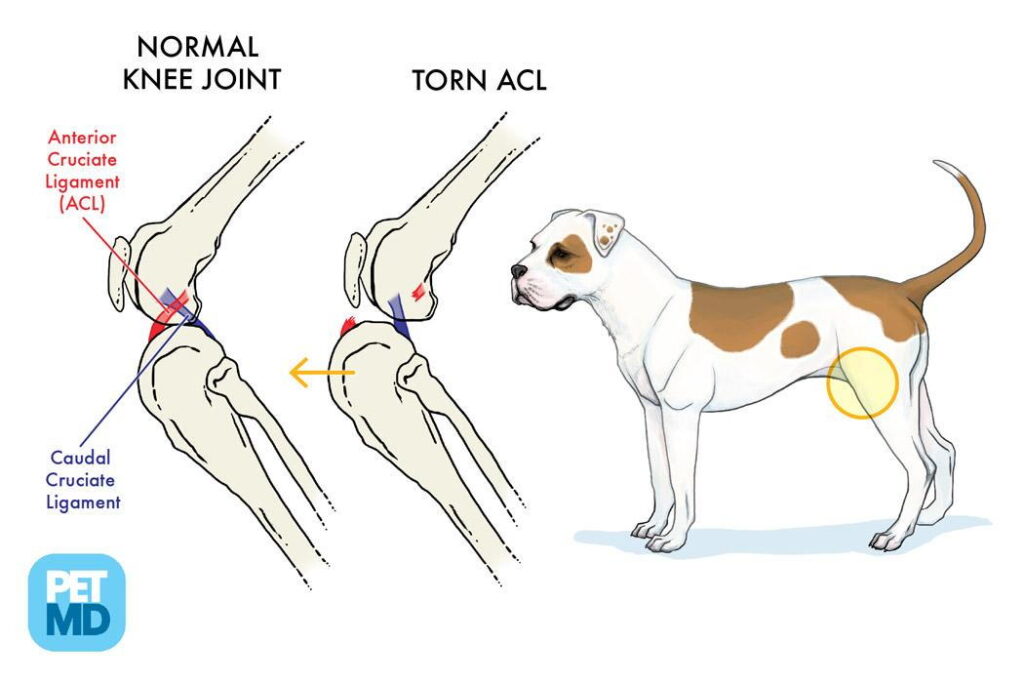
The most important symptoms and signs of a cruciate ligament tear in dogs
Dogs with a torn cruciate ligament typically have difficulty getting started, a bent position of the affected hind leg and only touching the ground with the tip of their foot. The muscles of the hind leg weaken and when sitting, the knee is placed under the stomach or spread to the side. Symptoms of pain only occur if the ligament tears further.
Cruciate ligament tear dog gait pattern
In most cases, cruciate ligament rupture in dogs is characterized by what is known as “ start-up lameness ”. Depending on the degree of injury, the degree of lameness varies. With smaller tears, your dog may limp slightly for a few days and then walk normally again. Such a previous injury increases the risk of a sudden jerk when your dog moves spontaneously and jerkily. Dogs also tense their hind leg and bring it into a flexed position. They usually do not lift their paw: if at all, only the tip of the paw touches the ground.
Your dog alternates between running fast and walking very slowly. The affected leg becomes thinner due to muscle loss. The cruciate ligament hurts with every additional cruciate ligament tear in a dog (otherwise dogs show no pain with degenerative tears ). With a traumatic cruciate ligament tear, your dog will exhibit sudden, severe lameness and pain . Your four-legged friend stretches his leg out to the side while sitting. The knee joint is swollen . The knee of your hairy nose becomes “hot” ( high heat ).
How is cruciate ligament rupture in dogs diagnosed?
A cruciate ligament rupture test in dogs is diagnosed with the so-called drawer test (tibial compression test for cruciate ligament rupture in dogs). With this test, the veterinarian checks the mobility of the knee joint. To do this, pull your lower leg towards your front legs. If the lower leg, in contrast to the thigh, can be pulled forward like a drawer, this indicates a tear in the anterior cruciate ligament. In addition, an effusion can be clearly felt. This test is usually easier to perform on small dogs than on larger breeds. Larger dogs have more muscle mass, which they contract during the test. For this reason, the drawer test can be negative even if your protégé has a torn cruciate ligament. An additional X-ray or CT to confirm .
How does a dog cruciate ligament tear occur: Degenerative or traumatic cruciate ligament tear?
A cruciate ligament tear (tear) can occur in two different ways:
a) Traumatic injury
On the one hand, an injury/torn cruciate ligament can occur in a dog as a result of an accident. In this case it is called a trauma or a traumatic fracture .
b) Degenerative rupture / degenerative cruciate ligament tear dog
If the cruciate ligament tears due to long wear and tear, medicine speaks of a degenerative rupture. Aging processes, poor posture and constant overuse can lead to tears in your dog's cruciate ligament, which become deeper over time. Therefore, with this type of cruciate ligament tear, it can be assumed that the cruciate ligament has already been damaged. Excess weight, strenuous physical exertion or an unusual shape of the shinbone promote degenerative cruciate ligament tears. The difference between a cruciate ligament tear in dogs and humans lies in the intensity of the tear. In dogs, in most cases the cruciate ligament does not tear completely, but fiber by fiber (cruciate ligament tear in dog hind leg).
Frequently asked questions about cruciate ligament rupture in dogs:
Can a torn cruciate ligament in a dog heal on its own?
Healing a torn cruciate ligament in a dog is unlikely to impossible on its own, as dogs during a cruciate ligament tear put more strain on the side that is not damaged and damage can also occur on the side that is not yet damaged.
How quickly does a torn cruciate ligament in a dog need to be operated on?
The urgency of surgery depends on several factors, including the severity of the injury, the age and general health of the animal, and individual circumstances.
In the case of complete cruciate ligament tears and in situations in which conservative therapy is not successful, surgery to restore joint function is usually necessary. The urgency of surgery varies depending on the factors mentioned above, but in general the procedure should be performed as soon as possible to ensure the best possible prognosis. In many cases, surgery is recommended within 1-2 weeks of diagnosis to minimize the risk of secondary damage to articular cartilage and other structures. Early intervention can help slow or prevent the development of osteoarthritis and other degenerative changes in the joint. However, in some cases, a longer waiting period before surgery may be considered, such as if the dog has other health problems that need to be addressed first.
What happens if you don't have surgery for a torn cruciate ligament?
If a cruciate ligament tear in a dog is not operated on, various complications can occur. The stability of the affected joint remains compromised, which can lead to increased instability and pain for the animal. In the long term, there is an increased risk of developing osteoarthritis and other degenerative changes in the joint. These chronic joint changes can limit the dog's mobility, reduce its quality of life, and increase the need for subsequent surgical intervention. Therefore, the decision not to undergo surgery for a torn cruciate ligament should be carefully considered and made in consultation with an experienced veterinarian.
Is a dog in pain from a torn cruciate ligament?
Yes, a dog can feel pain from a torn cruciate ligament. The pain results from the instability of the affected joint, the inflammatory reaction and possible accompanying injuries, such as damage to the meniscus. Pain intensity can vary depending on the severity of the injury and individual factors. Adequate treatment is therefore important to relieve pain and improve the dog's quality of life.
How much does cruciate ligament surgery on a dog cost?
A cruciate ligament rupture treatment in dogs is never an inexpensive matter. Simple procedures such as capsular lift start at EUR 900 plus physiotherapy etc. TPLO / TTA surgery start at EUR 2500 plus physiotherapy and aftercare. Artificial cruciate ligament replacement methods cost similarly, but the subsequent physiotherapy costs and medication costs are lower because the healing time is usually much faster. We therefore recommend that dog owners of dog breeds that are particularly at risk (we are seeing cruciate ligament tears, especially in young dogs, increasingly in Labradors, Golden Retrievers, all bulldog breeds or heavier dog breeds) take out surgery insurance or animal health insurance early on .
Cruciate ligament rupture dog surgery yes or no?
Cruciate ligament rupture in dogs Healing time without surgery: In small dogs, conservative treatment of cruciate ligament rupture in dogs is sometimes Non-surgical therapy includes special nutrition, joint protection, physiotherapy and medication administration. The aim of this healing method is to enable pain-free loading of the knee joint. However, this is not typically recommended by veterinarians. The reason for this is that if the cruciate ligament is not operated on, there is a risk of meniscus damage (cruciate ligament rupture in dogs without surgery).
In the worst case, both of your furry friend's cruciate ligaments will tear over time due to extreme overloading of the healthy, remaining ligament. Even non-operated cruciate ligament injuries can lead to cartilage damage and osteoarthritis. Surgery has the advantage that secondary damage rarely occurs. What surgical techniques are available for a torn cruciate ligament in dogs? When a cruciate ligament is torn, veterinarians have the choice between several different surgical methods. On the one hand, there are techniques that use the structures of the body's connective tissue or artificial materials.
Cruciate ligament rupture dog surgical methods
The path of the many surgical methods developed for cruciate ligament tears led via intracapsular and extracapsular techniques to modern osteotomies. What they all have in common is the assessment and, if necessary, treatment of the menisci (cleaning up, meniscectomy, etc.) and, as a crucial measure, the stabilization of the knee joint. A distinction is made between intra- or extra-articular techniques and those with or without ligament replacement. All common and proven surgical methods are used in our small animal center:
- Capsular fascia lifting according to Meutstege
- lateral thread reining and a mixture of 1&2 or
- Zlig (formerly: VetLig - intra-articular cruciate ligament replacement) or
- TTA Rapid or
- TPLO
Which cruciate ligament surgery method is right for your animal?
This depends on many factors, which we will be happy to discuss with you in advance by telephone without obligation after receiving your documents (you will find an inquiry form below).
The choice of surgical method depends on the physical characteristics of the patient (methods 1 & 2 are often not recommended for heavier patients), the degree of osteoarthritis of the joint, the involvement of the menisci and is ultimately also a question of cost. For you as a patient owner, this means that together we will determine the right path in the consultation.
In order to give you a comprehensive overview of all the main surgical methods for cruciate ligament ruptures in small animals (dogs/cats), here is an overview with the respective advantages and disadvantages from our own experience (since we offer and master all methods) from our point of view:
TPLO ( Tibial Plateau Leveling Osteotomy )
In this surgical method for a cruciate ligament tear, a quarter-circle bone incision is made at the upper end of the shinbone. The articular surface of the tibia bone is then rotated backwards according to a previously calculated amount. It is fixed in this new position with a bone plate and screws. The rotation reduces the inclination of the joint surface. The goal is a postoperative tilt of 5°.
The angle between the patellar ligament and the articular surface is then approximately 90°. In experiments it was found that with this inclination the cranial tibial thrust is neutralized and the tension on the anterior cruciate ligament (if it has not yet completely torn) is significantly reduced.
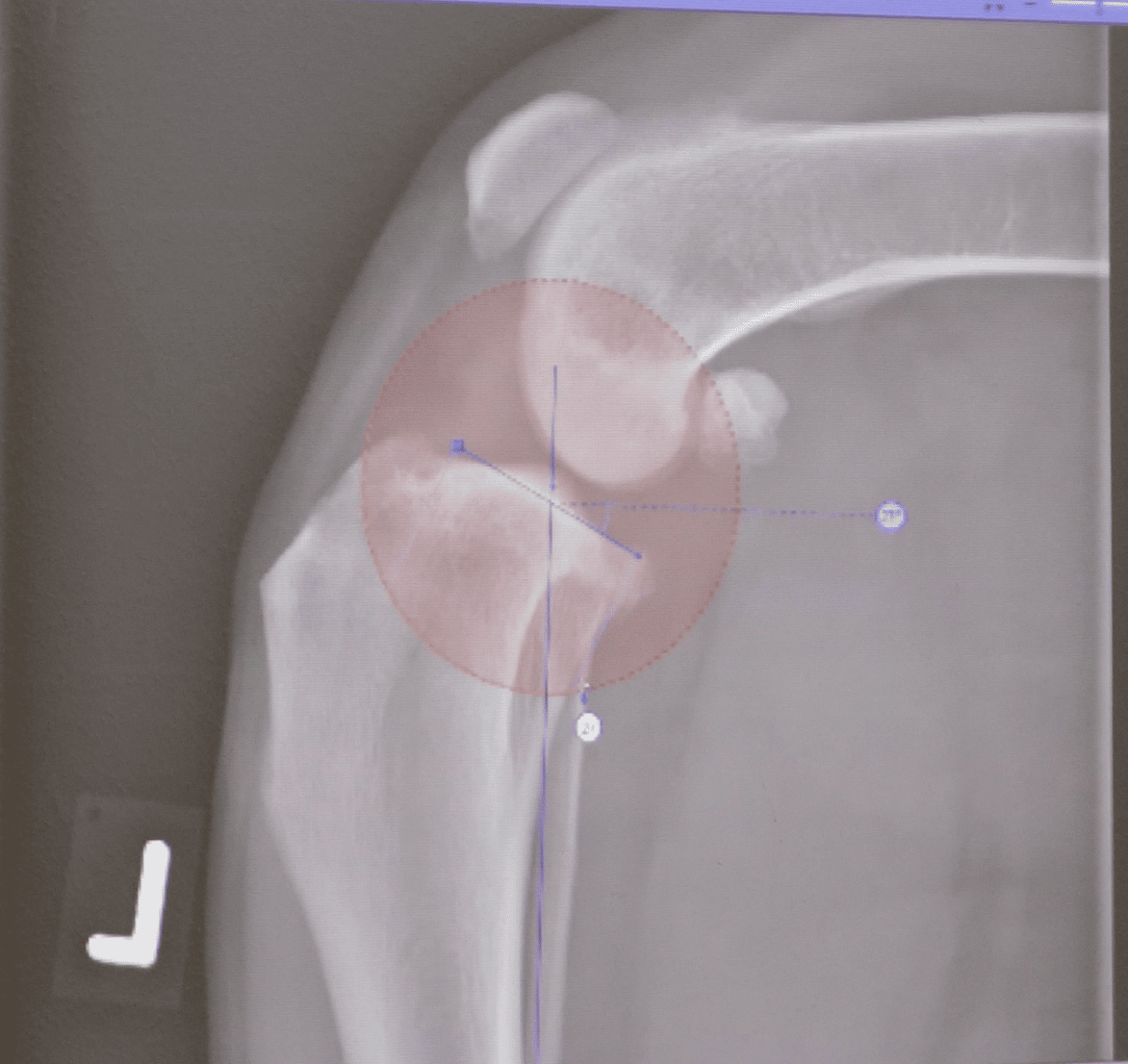
Advantages TPLO:
✓ Permanent and reliable stabilization of the knee joint even under heavy loads, even in animals with a high body weight
✓ for certain breeds and associated joint problems only possible solution (especially for dogs that are generally prone to cruciate ligament tears due to their anatomy (e.g. Old English Bulldog))
✓ the leading cruciate ligament surgery method in Germany
Disadvantages TPLO:
X serious surgery involving sawing of the bone
X Redirection of forces in an unnatural way
X long healing process
X relatively high price with all follow-up costs such as physiotherapy
TTA ( Tibial Tuberosity Advancement )
A method similar to TPLO is TTA (Tuberositas Tibia Advancement). Here, the cruciate ligament tear is also changed using a bone cut to change the biomechanics of the knee joint. By moving the patellar ligament forward, an almost right angle is achieved between the patellar ligament and the tibial joint surface, as with TPLO.
Advantages TTA:
✓ The load on the operated leg immediately postoperatively occurs somewhat faster than after a TPLO
Disadvantages of TTA:
X The load on the operated leg 1 year after TTA is slightly worse than one year after TPLO
X Greater progression of knee osteoarthritis
X Significantly higher number of meniscus injuries postoperatively than after TPLO
X Lower stability postoperatively than after TPLO (current studies by Prof. Böttcher, University of Leipzig)
You can find a comprehensive comparison between the two surgical methods TPLO & TTA (classic) in the dissertation by Dr. Monika Höpfl here.
TTA Rapid
The relatively new TTA-Rapid method can now achieve better results than the classic TTA method. The success rates are comparable to TPLO methods, which is why we will offer this method for special breeds for which the Vetlig method is not suitable.
Current studies on TTA-Rapid can be found here:
https://www.thieme-connect.com/products/ejournals/abstract/10.1055/s-0039-1684050
https://pubmed.ncbi.nlm.nih.gov/25330358/
TTA Rapid implant made from pure grade 1 titanium with a dodecahedron unit cell structure stimulates bone growth:
https://pubmed.ncbi.nlm.nih.gov/32344664/
Please see the following video for the TTA-Rapid method:
What is the difference between TPLO and TTA?
When the veterinarian performs a TPLO, he or she makes a circular incision on the dog's shinbone. He then places special plates in the appropriate places and screws the shinbone and the plates in a different position. The aim of this method is to prevent the leg from slipping biomechanically, so that the cruciate ligament's supporting function is no longer needed. During a TTA, additional plates and a spacer are screwed into the lower leg. Variations in the angle of the patellar tendon and altered fusion of bone structures also prevent the lower leg from sliding.
The advantage of both surgical techniques (compared to ligament replacement) is that the cruciate ligament can no longer tear because it has not been replaced. This makes it possible for your dog to be able to take part in sporting and protective activities again after healing and physiotherapy is complete. A significant disadvantage, especially in very young or very old dogs: It is highly likely that another operation on the cruciate ligament will no longer be possible and, in the worst case scenario, amputation will have to be carried out. our experiences with artificial cruciate ligaments such as the Zlig or Novelig from over 200 operations are very positive. Our Petlig Method® has proven particularly effective for bilateral cruciate ligament tears.
Ligament replacement, extracapsular (Ruby, Tightrope, Flo / Meutstege ligament replacement)
Extracapsular ligament replacement is often used for cruciate ligament rupture in smaller dogs. Here, a plastic band is attached outside the joint in the direction of the anterior cruciate ligament. The type of fixation varies depending on the surgical method. This can be done with bone anchors in the femur and tibia (Ruby), with drill holes in the femur and tibia (Tightrope) or on the sesamoid bone of the thigh and with drill holes in the tibia (Flo).
Advantages of extracapsular ligament replacement:
✓ Shorter anesthesia and surgery duration
✓ Cheaper price
✓ good experience with small and medium dog sizes
✓ faster healing process than with the aforementioned methods
Disadvantages of extracapsular ligament replacement :
X Replacement ligaments can tear again just like a normal cruciate ligament
X “Wearing out” (osteolysis) of the bone drill holes in the Tigthrope method, resulting in renewed instability
Ligament replacement, intracapsular - Zlig (formerly: VetLig)
This method has been used on humans for 25 years. The body's own or artificial material (tendons, parts of the patellar ligament, fascia) is used as a ligament replacement in place of the torn cruciate ligament.
For a long time, this method had not proven successful in cases of cruciate ligament rupture in dogs. Due to the insufficiently controllable stress on the knee joints in dogs after surgery, the ligament replacement tore again in many cases.
With the development of new materials in medical technology, it is now possible to give dogs / cats a surgical method that is considered state of the art for humans because it best replicates the animal's natural anatomy and, in contrast to TPLO / TTA, does not have any stressful changes to the bones.
After much preparatory work by Dr. Jacques.Pillipe Laboureau developed a synthetic band for intra-articular cruciate ligament replacement in small animals.
Using a tunnel technique, the Zlig is used as a total replacement for the cruciate ligament. The braided extra-articular parts of the ligaments are anchored in femoral and tibial bone tunnels by cannulated titanium interference screws.
This technique does not cause irreversible damage.
Advantages Zlig:
✓ Can also be used with very heavy dogs >70kg
✓ Replicating the natural anatomy without serious interference with the bone structure
✓ The patient's hind leg can be used again immediately (!) after the operation without any risks
✓ Lower costs than TPLO or TTA when you look at the total effort including follow-up treatment and physiotherapy
✓ especially at young animals This method does not prevent you from having to use Zlig or TPLO / TTA again later - the latter, however, are one-off and final
✓ a good solution for bilateral ligament ruptures in smaller dog breeds, because both cruciate ligaments can then be replaced in one operation with a single risk of anesthesia (Petlig Method®)
Disadvantages of Zlig:
X Higher costs than capsular fascia lifting according to Meutstege or lateral suture restraint
X not suitable for all breeds (see above - e.g. very rare for Old English Bulldogs)
Further information can be found on our dedicated Zlig page
Epidural anesthesia during our cruciate ligament operations - what does this mean for your loved one?
During all of our cruciate ligament operations, we try to treat your dog as gently as possible and avoid risks as much as possible. In other words, less depth of anesthesia due to this form of local anesthesia means less risk of anesthesia, even for older animals. You can find out more about the special topic of epidural anesthesia in our article Epidural anesthesia at TPLO
Non-binding advice
You can request a non-binding consultation from Ms. Veterinarian Arndt here:
Physiotherapy with the dog
Regardless of the surgical technique, dogs/cats should be given painkillers and, if necessary, cartilage building preparations after the cruciate ligament tear operation. The cruciate ligament healing time after a TPLO is approximately three months. In contrast, an artificial ligament replacement has a healing time of approximately one month. The most important measures during the healing process are consistent physiotherapy , regular weight checks and gentle exercise and leashing . We have summarized more information about physiotherapeutic measures here .
Prevention of cruciate ligament rupture in dogs
If your dog currently has healthy cruciate ligaments or has already had a ligament replacement, you can take active steps to prevent a (new) cruciate ligament tear. Since overweight dogs put more strain on their joints and cruciate ligaments, you should ensure that your dog maintains normal weight Additionally, you can support his joints with nutritional supplements . We would be happy to tell you which is the right remedy. If you want to do top-class sport with your dog , you should pay attention to the right age. High joint stress can lead to cruciate ligament tears in both puppies and older adults. A healthy, normal-weight adult dog, on the other hand, enjoys physical activity.
To reduce your dog's risk of a cruciate ligament tear, you should take some preventative measures:
1. Weight control
Obesity is a significant risk factor for cruciate ligament tears. Make sure your dog is at a healthy weight by providing him with a balanced diet and weighing him regularly.
2. Regular exercise
Make sure your dog gets regular exercise to keep his muscles and joints fit. However, make sure that the activities are not too intense and avoid sudden changes of direction or jumps, which could put a lot of strain on the joints.
3. Non-slip floors
Avoid slippery floors in your home as they can increase the risk of injury. Use non-slip mats or rugs to provide your dog with a secure footing.
4. Early detection of joint problems
If you notice signs of joint problems in your dog, see a veterinarian immediately. Early diagnosis and treatment can reduce the risk of ACL tears.

